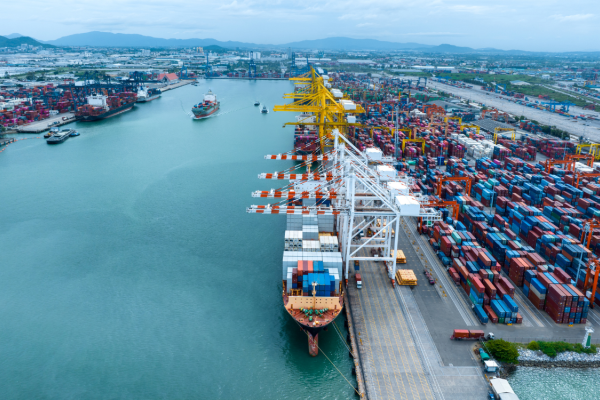
Lauren Wilgus
Published: April 11, 2025
Introduction
In the first 100 days of his second presidency, President Trump and his administration have taken several significant steps focused on promotion of the U.S. shipbuilding and maritime industry, including (1) the implementation of a USTR Proposal which includes new port fees on Chinese-operated and Chinese-built ships calling U.S. ports; (2) “reciprocal” tariffs on almost all imports into the United States; and (3) an April 9, 2025 Executive Order aimed at revitalizing America’s shipbuilding industry, strengthening its maritime workforce, and expanding the United States’ global shipping presence.
The Section 301 Proposed Action
Section 301 of the Trade Act of 1974 (“Section 301”) authorizes the United States Trade Representative (“USTR”) to investigate foreign trade practices and impose measures on foreign countries found to violate U.S. trade agreements or engage in acts that are “unjustifiable,” “unreasonable,” or “discriminatory” in ways that burden U.S. commerce.
On March 12, 2024, five major U.S. labor unions filed a Section 301 petition regarding alleged acts, policies, and practices of China to dominate the maritime, logistics, and shipbuilding sector. The petition was accepted, and on April 17, 2024, USTR initiated an investigation. Following its investigation, on January 16, 2025, in the last days of the Biden Administration, USTR published its report, titled “Report on China’s Targeting of the Maritime, Logistics, and Shipbuilding Sectors for Dominance” and determined that China’s practices were “actionable” (the “Report”).
On February 21, 2025, the USTR announced its proposed actions in connection with the Report (the “Proposed Action”). The Proposed Action includes the following fees and service restrictions:
Fees
As set forth in detail below, the Proposed Action provides fees to be applied to:
China-based operators;
Fleets with ships built in China; and
Operators with prospective orders for China-made vessels
As written, these fees could be cumulative, and in some cases could reach US $3.5m per port call.
Chinese Maritime Transport Operators:
A vessel operator of China to be charged a fee on the international maritime transport being provided:
At a rate up to US $1,000,000 per vessel entrance to a U.S. port; or
At a rate up to US $1,000 per net ton of the vessel’s capacity per entrance to a U.S. port.
Maritime Transport Operators with Fleets Comprised of Chinese-Built Vessels:
Upon the entrance of a Chinese-built vessel to a U.S. port, a fee to be charged to that vessel’s operator on the international maritime transport provided via that vessel:
At a rate up to US $1,500,000 per vessel entrance to a U.S. port;
Fees based on the percentage of Chinese-built vessels in the operator’s fleet:
for operators with 50 percent or greater of their fleet comprised of Chinese-built vessels, the operator will be charged up to US $1,000,000 per vessel entrance to a U.S. port;
for operators with greater than 25 percent and less than 50 percent of their fleet comprised of Chinese-built vessels, the operator will be charged a fee up to US $750,000 per vessel entrance to a U.S. port; or
for operators with greater than 0 percent and less than 25 percent of their fleet comprised of Chinese-built vessels, the operator will be charged a fee up to US $500,000 per vessel entrance to a U.S. port; or
an additional fee of up to US $1,000,000 will be charged to a vessel operator per vessel entrance to a U.S. port if the number of Chinese-built vessels in the operator’s fleet is equal to or greater than 25 percent.
Maritime Transport Operators with Prospective Orders for Chinese Vessels:
An “additional fee” based on the percentage of vessels ordered from Chinese shipyards:
up to US $1,000,000 per vessel entrance at a U.S. port if greater than 50% of their vessel orders in Chinese shipyard or vessels expected to be delivered by Chinese shipyards over the next 24 months;
up to US $750,000 per vessel entrance at a U.S. port if between 25% and 50% of their vessel orders in Chinese shipyard or vessels expected to be delivered by Chinese shipyards over the next 24 months; or
up to US $500,000 per vessel entrance at a U.S. port if between 0% and 25% of their vessel orders in Chinese shipyard or vessels expected to be delivered by Chinese shipyards over the next 24 months; or
a fee up to US $1,000,000 per vessel entrance at a U.S. port if 25% or more of the total number of vessels ordered by an operator, or expected to be delivered to the operator, are ordered or expected to the delivered by Chinese shipyards over the next 24 months.
Refunds:
The Proposed Action includes a proposed “refund” for additional fees, on a calendar year basis, up to US$1,000,000 per entry into a U.S. port of a U.S.-built vessel through which the operator is providing international maritime transport services.
The Proposed Action does not include any further details as to the timing of refunds or the process to obtain a refund.
Service Restrictions
The Proposed Action also includes restrictions on services aimed at promoting the transport of U.S. goods on U.S. vessels. Under the Proposed Action, the international maritime transport of all U.S. goods (e.g., capital goods, consumer goods, agricultural products, and chemical, petroleum or gas products), must comply with the following schedule:
Effective Date of Action: at least 1% of U.S. Products, Per Calendar Year, Exported by Vessel, Restricted to Export on U.S.-Flagged Vessels by U.S. Operators;
2 Years Following Effective Date of Action: at least 3% of U.S. Products, Per Calendar Year, Exported by Vessel, Restricted to Export on U.S.-Flagged Vessels by U.S. Operators;
3 Years Following Effective Date of Action: At least 5% (at 3% of which must be U.S.-flagged, U.S.-built, by U.S. Operators) of U.S. Products, Per Calendar Year, Exported by Vessel, Restricted to Export on U.S.-Flagged Vessels by U.S. Operators;
7 Years Following Effective Date of Action: At least 15% (at 5% of which must be U.S.-flagged, U.S.-built, by U.S. Operators) of U.S. Products, Per Calendar Year, Exported by Vessel, Restricted to Export on U.S.-Flagged Vessels by U.S. Operators.
The Proposed Action also includes a requirement that U.S. goods are to be exported on U.S.-flagged, U.S. built vessels, but may be approved for export on a non-U.S.-built vessel provided the operator providing international maritime transport services demonstrates that at least 20% of the U.S. products, per calendar year, that the operator will transport by vessel, will be transported on U.S.-flagged, U.S.-built ships.
Other Actions
The Proposed Action includes a recommendation that relevant U.S. agencies take actions to reduce exposure to and risk from China’s promotion of the National Transportation and Logistics Public Information Platform (LOGINK) or other similar platforms, including investigating alleged anticompetitive practices from Chinese shipping companies, restricting LOGINK access to U.S. shipping data, or banning or continuing to ban terminals at U.S. ports and U.S. ports from using LOGINK software.
Next Steps:
The Proposed Action is not final. As of April 2, 2025, there were 586 submissions to the public docket. The public hearings were held at the US International Trade Commission on Monday, March 24, 2025, and continued on Wednesday, March 26, 2025. Transcripts of the Hearings are publicly available on USTR’s website. Post-hearing rebuttals and comments may be submitted for consideration within seven days after the last day of the public hearing.
The USTR is currently studying the voluminous feedback from the testimonies and written submissions made in connection with the Hearings to determine the desirability and feasibility of the proposal. Notably, at a Senate Finance Committee meeting on April 8, 2025, Reuters quoted US Trade Representative Jamieson Greer as saying the port fees were “proposed actions or series of potential revenue,” and may not be cumulative, adding that “they’re not all going to be implemented. They’re not all going to be stacked.”
Section 301 cases are supposed to be completed within 1 year, and then implemented 30 days after. However, the White House may extend that period up to 180 days.
The Reciprocal Tariffs
President Trump announced new tariffs on April 2, 2025, which he referred to as “reciprocal tariffs,” on almost all imports into the United States. According to a paper issued by the USTR, the reciprocal tariffs “are calculated as the tariff rate necessary to balance bilateral trade deficits between the United States and our trading partners.”
On April 9, 2025, President Trump paused the “reciprocal” tariffs on most countries, excluding China, opting instead to raise tariffs on all Chinese imports to 125% from 104% after China announced additional retaliatory tariffs against the United States earlier the same day. All other countries that were subjected to reciprocal tariff rates are still subject to the universal 10% rate, and 25% for Mexico and Canada.
On April 10, 2025, the European Union announced a 90-day pause on countermeasures against the United States, in response to the Trump administration’s similar pause.
The April 9, 2025 Executive Order
Since the USTR released its Proposed Action, the Trump administration has taken several significant steps focused on promotion of the U.S. shipbuilding and maritime industry.
On April 9, 2025, President Trump signed an Executive Order titled “Restoring America’s Maritime Dominance” (“Executive Order”). The Executive Order establishes several key initiatives with specific deadlines, including a directive to the USTR in connection with its Section 301 Proposed Action. In particular, Sec. 5 of the Executive Order provides, in relevant part:
Sec. 5. Actions in the Investigation of the PRC’s Unfair Targeting of Maritime, Logistics, and Shipbuilding Sectors.
Sec. 5. Actions in the Investigation of the PRC’s Unfair Targeting of Maritime, Logistics, and Shipbuilding Sectors. With respect to the actions, if any, that the USTR determines to take consistent with the USTR’s notice of public hearing entitled Proposed Action in Section 301 Investigation of the PRC’s Targeting of the Maritime, Logistics, and Shipbuilding Sectors for Dominance, 90 Fed. Reg. 10843 (February 27, 2025), the USTR shall:
coordinate with appropriate agencies to collect additional information, as appropriate and to the extent permitted by law, in support of administering such actions; and
coordinate with the Attorney General and Secretary of Homeland Security to take appropriate steps to enforce any restriction, fee, penalty, or duty imposed pursuant to such actions.
Based on the USTR’s determinations arising out of its Section 301 investigation into the PRC’s targeting of the maritime, logistics, and shipbuilding sectors, the USTR shall also consider taking all necessary steps permitted by law to propose the following actions
tariffs on ship-to-shore cranes manufactured, assembled, or made using components of PRC origin, or manufactured anywhere in the world by a company owned, controlled, or substantially influenced by a PRC national; and
tariffs on other cargo handling equipment.
Conclusion:
The Club will continue to monitor any developments in connection with these evolving regulatory changes under the Trump Administration. Members are also advised to contact their local agents for the latest advice.


